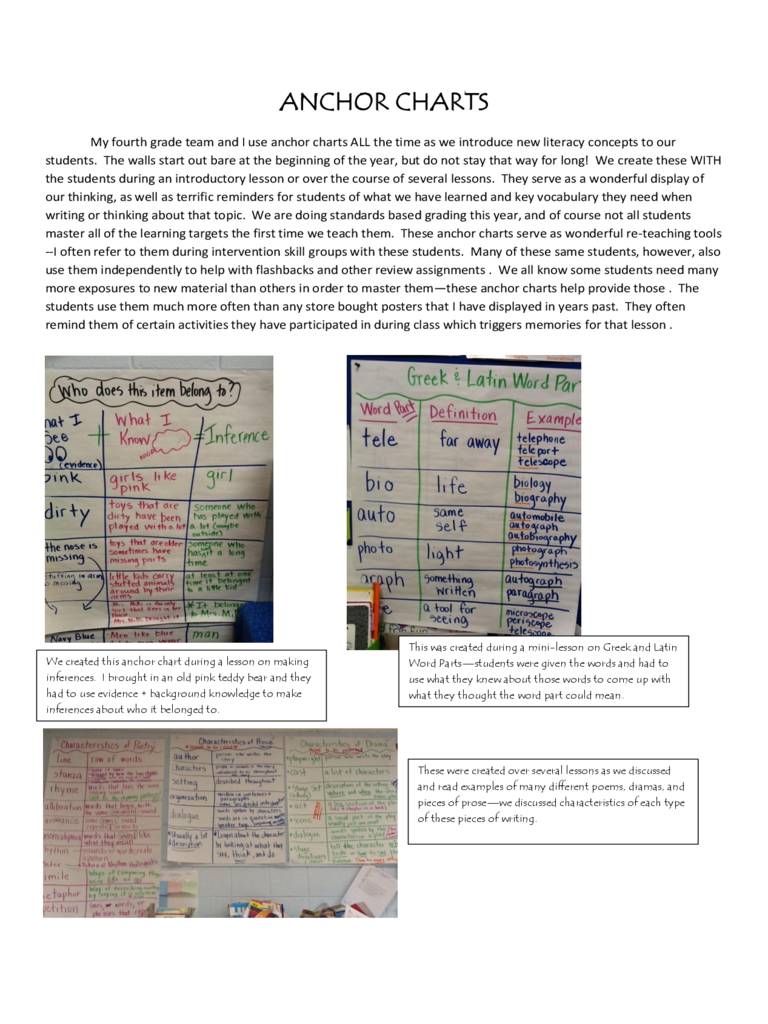Fillable Printable Sample Anchor Charts Template
Fillable Printable Sample Anchor Charts Template

Sample Anchor Charts Template

ANCHOR CHARTS
My fourth grade team and I use anchor charts ALL the time as we introduce new literacy concepts to our
students. The walls start out bare at the beginning of the year, but do not stay that way for long! We create these WITH
the students during an introductory lesson or over the course of several lessons. They serve as a wonderful display of
our thinking, as well as terrific reminders for students of what we have learned and key vocabulary they need when
writing or thinking about that topic. We are doing standards based grading this year, and of course not all students
master all of the learning targets the first time we teach them. These anchor charts serve as wonderful re-teaching tools
--I often refer to them during intervention skill groups with these students. Many of these same students, however, also
use them independently to help with flashbacks and other review assignments . We all know some students need many
more exposures to new material than others in order to master them—these anchor charts help provide those . The
students use them much more often than any store bought posters that I have displayed in years past. They often
remind them of certain activities they have participated in during class which triggers memories for that lesson .
We created this anchor chart during a lesson on making
inferences. I brought in an old pink teddy bear and they
had to use evidence + background knowledge to make
inferences about who it belonged to.
This was created during a mini-lesson on Greek and Latin
Word Parts—students were given the words and had to
use what they knew about those words to come up with
what they thought the word part could mean.
These were created over several lessons as we discussed
and read examples of many different poems, dramas, and
pieces of prose—we discussed characteristics of each type
of these pieces of writing.

*Students also have reading/writing journals that have a resource section—they add anchor charts to this notebook as well. Sometimes, it is a
graphic organizer type sheet they glue in and fill in, and sometimes, they create something to use as an anchor chart for certain topics.
**The sticky charts are great because you can just stick them up anywhere, but they are more expensive than just the plain chart paper. We
actually use the plain chart paper, but hang them on 3M hooks. This allows us to “layer” them and then easily switch the charts around as needed.
These two anchor charts were created during several different lessons on theme—we charted different themes we found
in texts we were reading. We also read several Patricia Polacco books during these lessons and charted the theme we
found, as well as text support from each text. (P.Polacco books have wonderful themes!) After these lessons, students
often stop me during read alouds to say “I think I know what the theme is!” They use these charts for reference all the
time!
Rules of Dialogue—This chart was created as a whole group
after students worked in small groups to look through
various literary texts and record what they observed about
the rules of dialogue. After self-discovering some of these
rules, we created this class anchor chart— a sample of writing
with rules written all around.
We made this chart after
reading different examples
of firsthand and
secondhand accounts.
Created after a brainstorming session about
different words we could use to describe
characters –before this students wanted to
just say characters were “happy” or “sad.”



